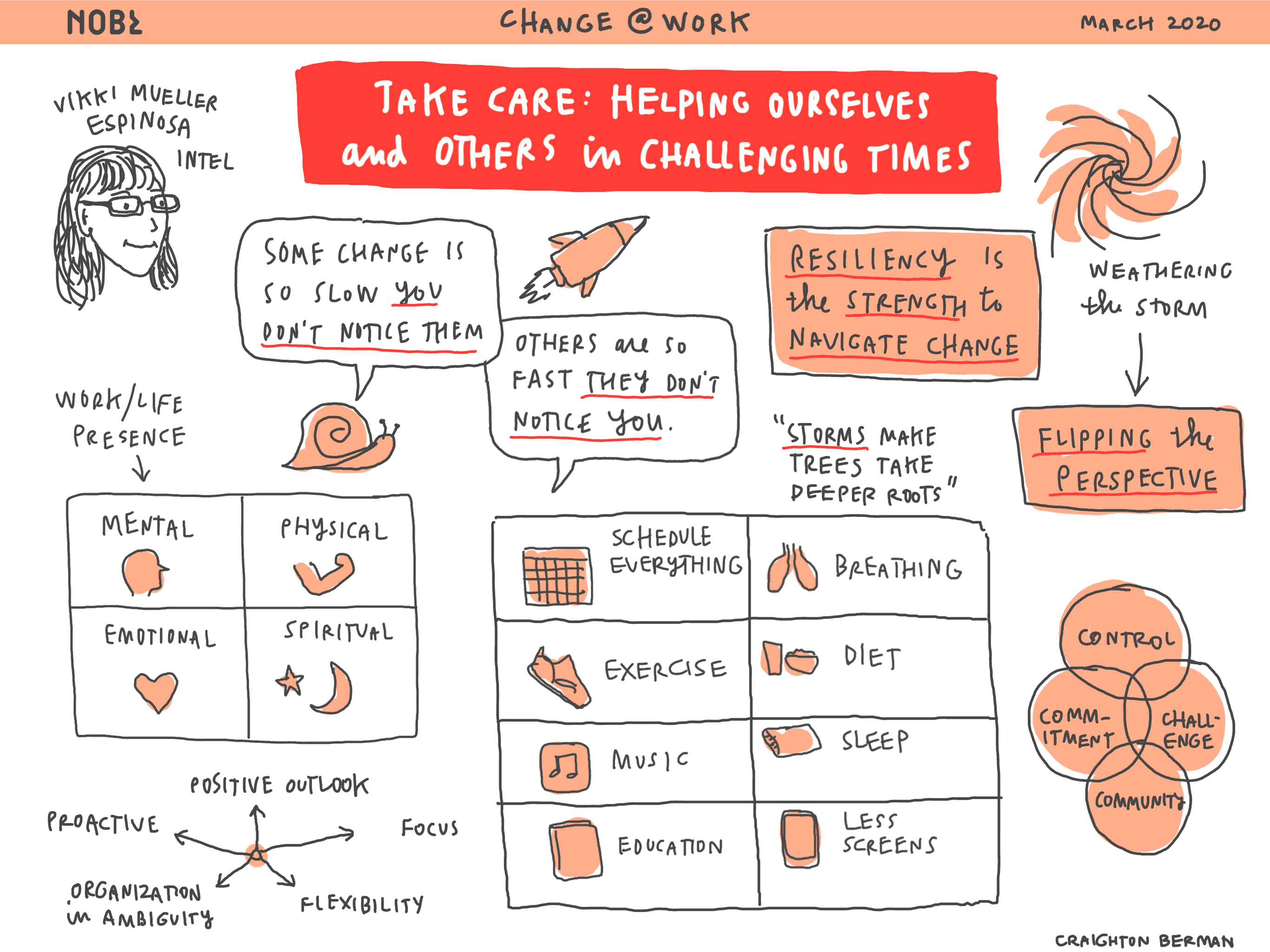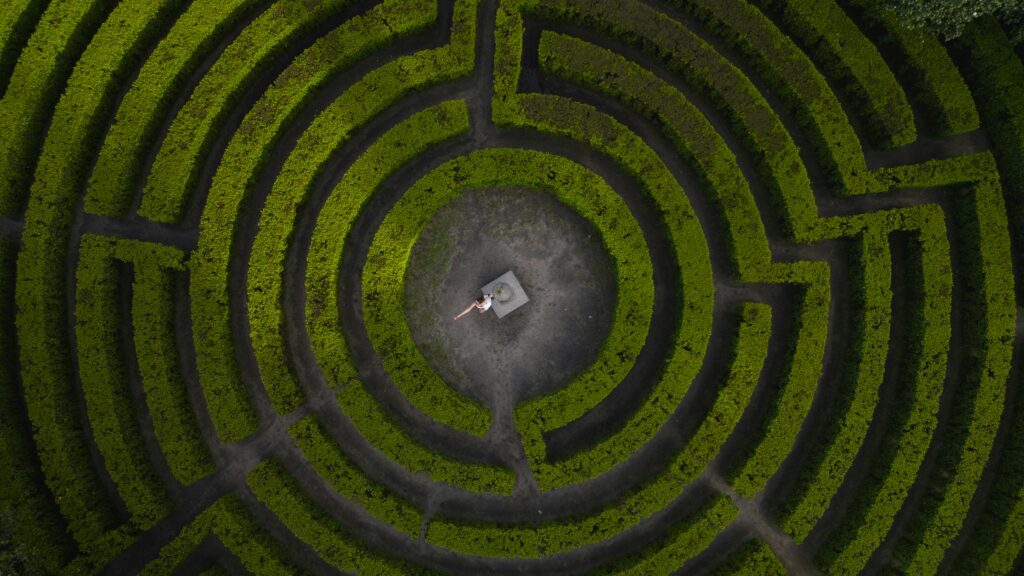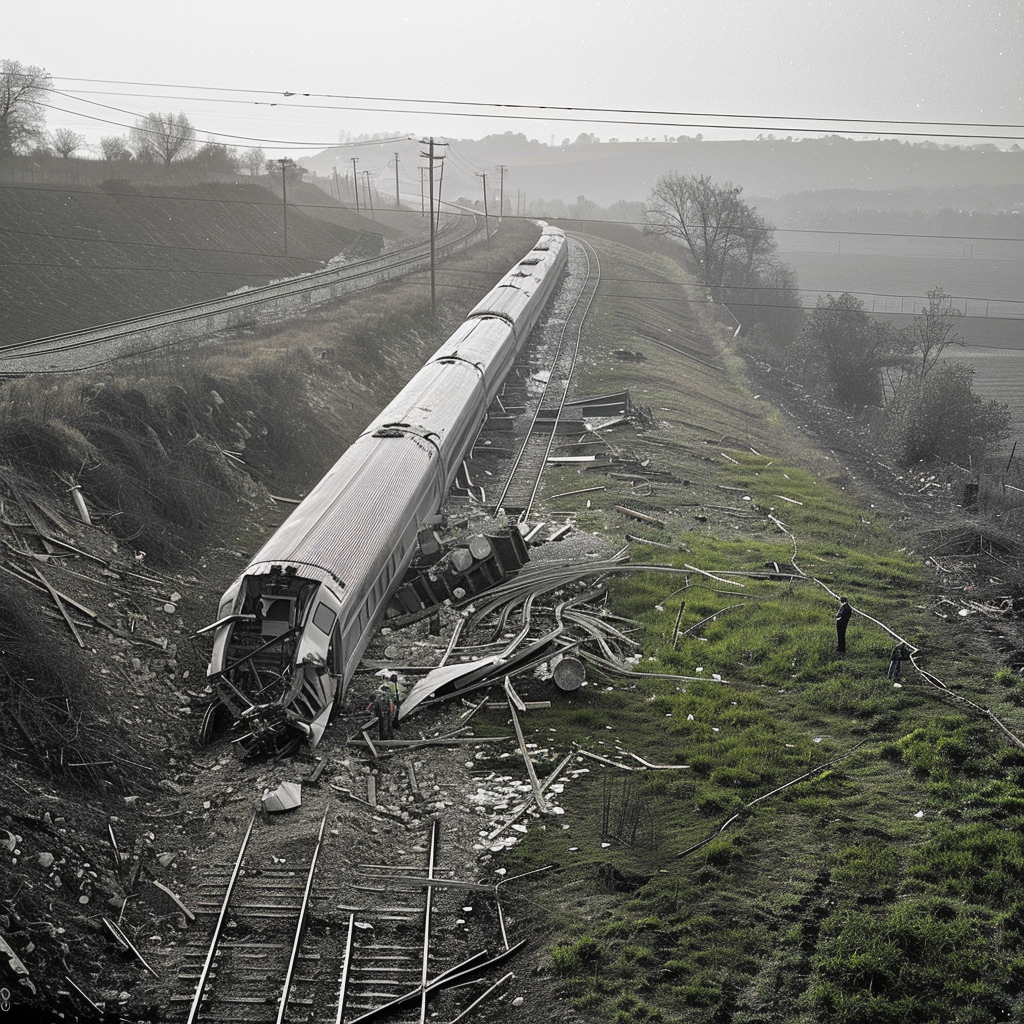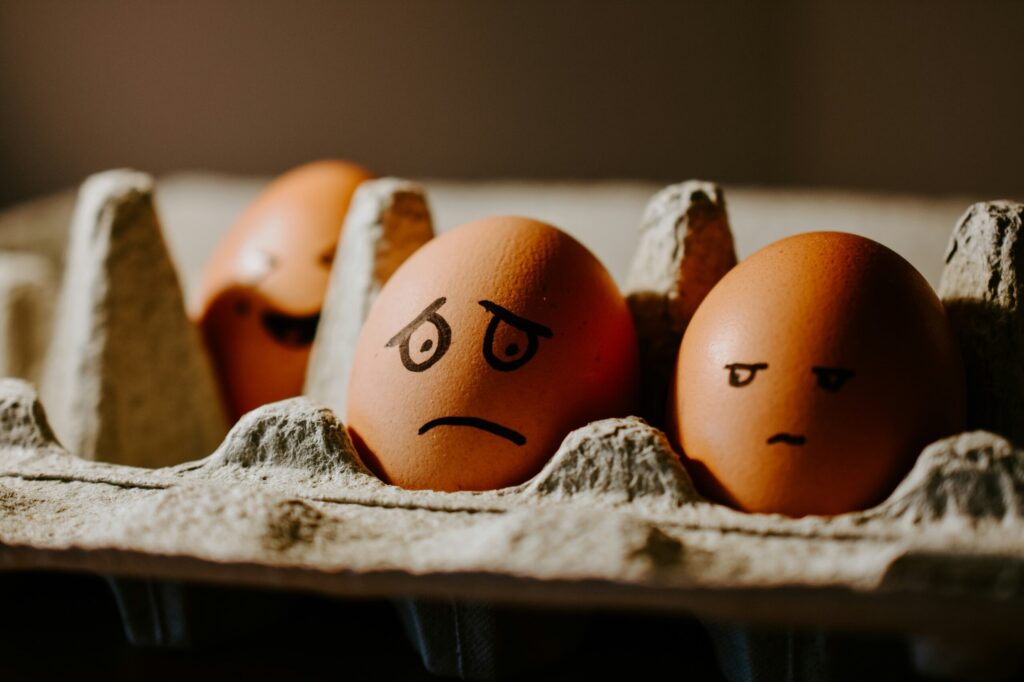In her role as People Program Director and Career Strategist at Intel, Vikki Mueller Espinosa advises employees on their career development and self-discovery. She shared some practical tips for maintaining resilience in these fast-moving times:
- Think about how you want to respond. In the face of change, it’s easy to slip into “fight or flight” mode. Instead, think about what you can control or influence, and what strengths or passions you can contribute.
- Check in with yourself. When you encounter a change, take a moment to step back and analyze how it’s affecting you mentally, physically, and emotionally.
- Don’t neglect the basics. To increase personal resiliency, make sure you’re prioritizing self-care, including everything from exercise, sleep, and good diet, to listening to music!
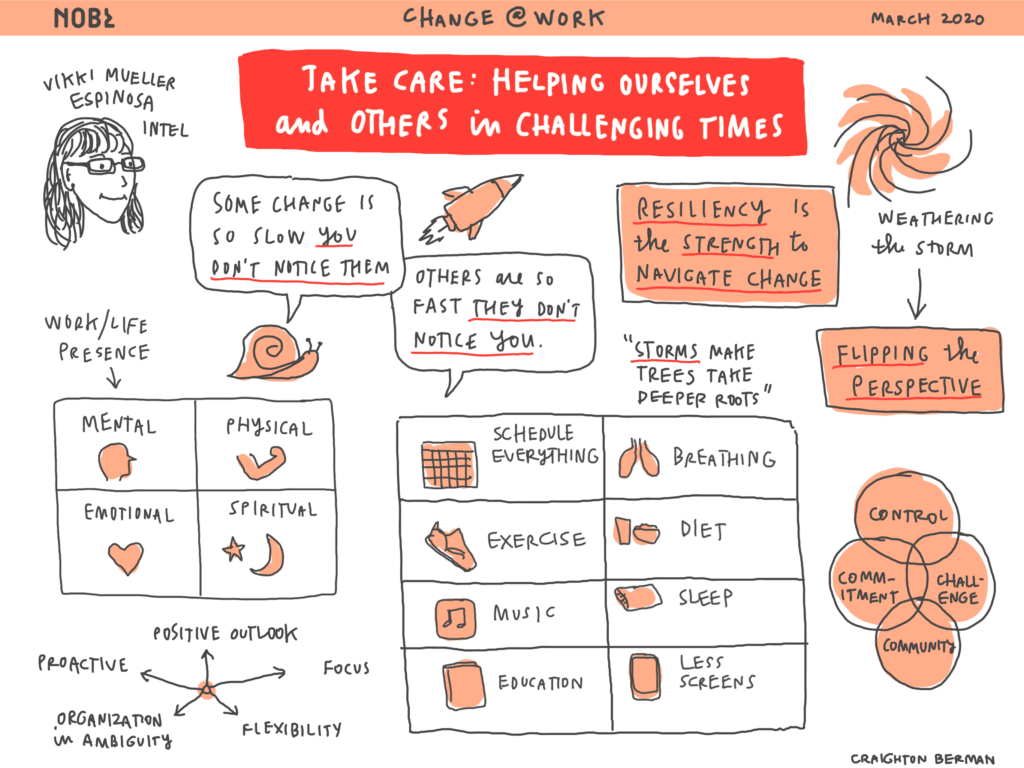
Read the Transcript
Vikki Mueller Espinosa:
Welcome. As you heard, my name is Vikki. I work at Intel Corporation. I’ll tell you a little of my backstory. Back in 2009 I suffered a catastrophic knee injury in a soccer game. That incident left me with a permanent disability. Four surgeries and a year later, I relearned how to walk with permanent nerve damage and a palsy, which is commonly called foot drop. At the time of the injury, I had two young daughters and a two-story house with the showers on the second floor. I’ve learned and practiced resiliency concepts and behaviors, especially over the last 11 years.
I went from playing soccer to fencing. Yes, you heard me right, with swords. I prefer the epee, for those of you who are familiar with the sport. I started playing in a chair for Team USA back in 2016. I missed fencing for the US in the 2016 Rio Paralympics by about six points. My young teammate from Ohio got to go to the Paralympics. That’s okay. I learned a lot through the process, and I’m really honored to be here today to share some tactical and practical ideas on how to build resiliency by taking care of yourself.
In my day job, I work with people to define their career development plans and one of my strengths is helping others through the self-discovery process, so they can do what they love every day and love what they do. I’m known for giving tactical and practical tips. Those are things that my mentees and blog readers can put into practice right away, and help them make strides in their careers and in some ways their lives overall. I hope you find some actionable and easy-to-implement ideas from today’s presentation and I’m looking forward to an interactive section. So please be prepared to use the chat box throughout the talk, and let’s get started.
Some changes are so slow, you don’t notice them, and others are so fast, they don’t notice you. Never before has this been more true. Using the chat box, tell me how fast are things moving for you in the past day or the past week, or the past two weeks. What’s going on with all of you? All right, Sarah, you want to give me an idea of what people are saying?
Sarah Dickinson:
I can. I can. We have got some themes here. Slow and fast. I think, is the general consensus too fast, too slow? Every day feels like a decade. It feels like very much the quality of time has completely shifted exponentially fast. Did the news come out this morning or was that three days ago?
Vikki Mueller Espinosa:
Yes.
Sarah Dickinson:
Right?
Vikki Mueller Espinosa:
We’re going through all of this right now. Resiliency, what that is, is really about having the strength required to navigate change. So change is coming at us now fast, slow, all over the place. It’s also to master the consequences of the change. So the change is bringing different things. It’s the ability to renew ourselves and integrate that new learning. It’s how we recover quickly from change, hardship, misfortune. It’s how we show flexibility, durability, an attitude of optimism, openness for learning. If we are missing resilience, it shows up in burnout, fatigue, malaise, depression, defensiveness, cynicism.
So bringing in resiliency helps you have tools to handle hardship and disappointment, and also helps you develop new skills and perspectives that lead to continued success at work and away from the job, at home. So let’s go a little deeper. What happens when we react to change and adversity in a counter-productive and non-resilient way? What does that look like? We expect perfection. We go into what was mentioned earlier, fight, flight or freeze. Or we may lay the blame, we may play the victim. We could get negative and pessimistic, or give up doing anything, or try to control everything. We could forget our own strengths and passions.
We could hide. That’s easy right now as we’re all in our houses. We could lose all sense of purpose and meaning. We could burn out or freak out, or spin out, or we could learn nothing and doom ourselves to repeat history. What could we do instead? How could we respond differently? What if we moved to expecting the unexpected, or finding calm in the eye of the storm, or rising to any challenges that come our way, or really looking to maximize the positive? The one I’m focusing on right now is I always wanted to bring my dog to work. Now I bring my work to my dog and we hang out all day. So that’s working. Minimize the negative. Control, influence, or just let go.
Then from there we can leverage our strengths and passions. What can we contribute to our friends, our family and others? What strengths do we have? Can we strengthen our connections with our community? We’ve got great tools. We’ve got Zoom, we’re on it today. We’ve got WebEx, we’ve got FaceTime, we have Houseparty apps, all sorts of things. Can we connect with meaning and purpose? Can we restore, renew, refresh, and recover? Can we grow and learn through this adversity? I ask you now, which tactic will you try? Pick a number and put that action item in the chat.
Sarah Dickinson:
Okay. Highly scientific data analysis here.
Vikki Mueller Espinosa:
No, why not?
Sarah Dickinson:
We got some, I see lots of nines.
Vikki Mueller Espinosa:
That’s nice.
Sarah Dickinson:
Yes, yeah. That’s lots of nines, threes, fours.
Vikki Mueller Espinosa:
All right, excellent.
Sarah Dickinson:
It’s across the board, across the rainbow.
Vikki Mueller Espinosa:
All right, you liked it all. So restore, renew, refresh and recover.
Sarah Dickinson:
Yeah.
Vikki Mueller Espinosa:
Great way to do that is … we’ll get into some actual tactics in a few minutes, but we’ll focus on those and we’ll see what we can do. There are four areas to start focusing on when change occurs. To take a step back and ask yourself how you are doing in these four presence areas. The first one is mentally. What’s going on in your head? Are you able to focus? Are you paying attention? What’s happening for you? What’s going on around you? Physically, what’s happening with you? We did this beautiful exercise just before I started speaking, to talk about being mindful of what’s happening inside our bodies. Are we feeling tight? What’s happening for us? Headspace is a great app to help us with that, but really think about how do we get our shoulders up and back? How do we release our tension.
Emotionally. Are we sad? Are we scared? What are we feeling? How can we process them without really allowing them to take over? Go through and maybe talk to our loved ones, talk to people about what we’re feeling so that we can find ways to adapt. Lastly, but not least, is spiritually. So thinking about the bigger picture, how staying home is contributing to the safety of others. How we can contribute to making the world a better place. Are you able to sew? It looks like they’re calling for people to sew face masks right now. Can you contribute your strengths? Can you contribute your passions and your capabilities to making the world a better place?
Let’s get into the tactics, right down into there. First thing I recommend is, schedule everything. You may want to, on the weekends, leave it completely open. But during the week, I have now scheduled lunch with my husband and daughter so that we’re all eating together. I’ve scheduled breaks so I can walk with my dog and stretch. What’s on your calendar? What’s going on for you? Exercise, super important. Take care of yourself physically. I used to lift weights two times a week, attend Pilates, walk my dog, do all of these things. I’m now having to be creative on how to do that. I’ve noticed a lot of yoga practitioners giving Instagram yoga classes. What can you do?
Music. Music is huge for me. Changes my mood in an instant. I’m sure you’ve felt that as you turned on your favorite song and you sing along in your car, it makes the traffic not so bad. What can you do to bring music back into your life right now? Breathing. We talked about that a little bit earlier. Diet, we’re home. We’re sedentary, we’re not moving as much. Are you watching what you’re eating? I’m now logging everything to make sure I’m keeping track of my calories, and I’m standing on that scale every morning to keep myself accountable and make sure I’m not putting on the Pandemic 20. Remember the Freshman 15? We want to make sure that the Pandemic 20 doesn’t become a thing.
Sleep. Are you getting enough sleep? Are you going to bed? Less screens. Are you staying away from the lights that are keeping you awake? Are you turning off your computer and walking away at an appropriate time, so that you can spend time with yourself maybe, or in nature walking? Then education. That really helps us with understanding our fears, figuring out what we can do, helping us be smarter so that we can work better at taking care of ourselves. Out of these, which one are you going to work on? What will you focus on first? What did we see?
Sarah Dickinson:
Let’s have a look, so many good practices here. Exercise, sleep, scheduling, schedule everything.
Vikki Mueller Espinosa:
Yeah.
Sarah Dickinson:
We stole Rachel’s schedule from this morning, the CEO of Honey. I kind of want that spreadsheet.
Vikki Mueller Espinosa:
Excellent.
Sarah Dickinson:
Yeah, she’s got the spreadsheet down. The scheduling is popping off the charts here.
Vikki Mueller Espinosa:
Yeah.
Sarah Dickinson:
Exercise. Yeah.
Vikki Mueller Espinosa:
Definitely helps us separate. Yeah.
Sarah Dickinson:
It does. Yeah.
Vikki Mueller Espinosa:
Very good.
Sarah Dickinson:
I think people are going to be doing all of them, and I love that people are probably leaning into sort of, “Where am I strongest right now? What needs more attention?” Sort of creating that balance, you know?
Vikki Mueller Espinosa:
Yes.
Sarah Dickinson:
That’s what I’m hearing for you.
Vikki Mueller Espinosa:
Right. Don’t miss one. Really think about these. Those quiet moments of breath and breathing are just as important as getting out there and pumping your fists and walking as fast as you can to get your heart rate up. All of these things are important, and I love bringing music back in. That’s been super helpful to me in these times that are trying and hard. All right, so the four Cs of resiliency, let’s talk about them.
Kobasa in 1979 defined hardiness as a cognitive appraisal process composed of three characteristics: control, commitments, and challenge. So let’s talk about them. Commitment, involving staying true to your values, right? And your ideas or your ideals, staying on course to achieve your goals and vision. So don’t let go of those things that you were working on. You may have to do them a little differently. Challenge. How are you looking at change? If you view it as a challenge instead of something that is happening to you or something bad, you usually generate the positive energy to conquer it.
Control. So can you control, in bringing that right discipline in to not let it overwhelm you? Having control means being firm in the conviction that you have power. So this means turning off the screens, stop watching CNN, leave those things that are making you crazy out for a little while. You have the control to turn it off. Then community, I’m spending time talking to friends and family and people that I haven’t talked to in a really long time. So who can you get onto FaceTime with? I want you to remember that storms make trees take deeper roots. A tree that is rooted and flexible bends in the wind. A tree with high branches and thick bark resists fire on the forest floor. How can you take deeper roots? What will you turn to to feed your body and soul to build your resilience? I’ve given you some ideas.
Those are things from within, so let’s think about outside. Think of the resilient people you have known. What were they like? For this exercise, I picked Sheryl Sandberg. She’s been through so much. She lost her husband on vacation. She had to figure out how to get back to her very visible and public job. Then she wrote a book about it. I am continuously inspired by her resilience, her openness, and how she shares what she learns with others. So in the box, who do you admire for their resilience, and what attributes do they have that you would like to be better at or grow in? What are we seeing?
Sarah Dickinson:
Perspective.
Vikki Mueller Espinosa:
Perspective, I like that.
Sarah Dickinson:
Yeah. Humor.
Vikki Mueller Espinosa:
Humor.
Sarah Dickinson:
Expectation. Somebody is talking about their best friend. She always shows up.
Vikki Mueller Espinosa:
Love it.
Sarah Dickinson:
Forgiveness. Empathy. Confidence.
Vikki Mueller Espinosa:
So nice.
Sarah Dickinson:
Peace.
Vikki Mueller Espinosa:
Great.
Sarah Dickinson:
Wonderful.
Vikki Mueller Espinosa:
Each of you has these strengths and capabilities. You’ve done probably different personality assessments and surveys. There are things that you are known for. How do you use those to help others in your family, in your circle, at your work? What are you doing to help? So think about the five strategies of resilient people. This comes from Daryl Conner’s study of resilient people. Positive outlook. So how can you bring positivity in? Proactive. Can you get ahead of the possible change and prepare yourself for any eventuality that might be coming your way?
Organization in the face of ambiguity. So they ask us to have tolerance of ambiguity, but can we remain organized, organize our tests, our documents, our plan of action, our calendars, our schedules, and then keep track of what we’re actually accomplishing? As you cross those things off, as you complete them, as you remain organized, take some kudos for yourself. Flexibility is the next one. Being willing to compromise if necessary. It can make difficult situations less taxing. So my 16-year-old daughter told me yesterday, she was standing in the line in the supermarket, that she let a couple of people go ahead of her because they had less stuff. So she showed flexibility and, “I can wait, I don’t have to be anywhere. I’ll let these other folks go. I’ll let them get out of here sooner.” I thought that was pretty cool.
Focus. Can you keep your eye on the intended objective, so these short-term changes don’t derail you from the big picture? What is your big picture plan for 2020? Have you gone back and looked? Are you on track? Are there things that you could do or schedule? From there, I am encouraging you to have an action plan from today, from the ideas that I’ve shared, from the ideas others have shared. What can you and will you do in the next couple of days? What must you do in the next month or two, and what steps will be required in the next six to eight months? Now, shifting a little, how do you handle it if someone is resistant to what’s going on? Talk to your family, your friends. Take a walk, set up a video chat, do some exercise challenges using tracking devices. You can be friends on your Fitbit or your iWatch or whatever device you use.
Maybe help someone who’s really struggling with worst-case scenario planning. “What’s the worst thing that could happen? Okay, if that happens, what are we going to do? What steps will we take? Can we plan our way out of it?” Who will you go teach some of these things and what will you teach them? What new ideas will you share? My example here is I will take Brenda for a walk, keeping six feet between us at all times for physical distancing. You’ll notice I don’t call it social distancing because we can be very socially connected. We’re just asked not to be physically connected right now. So with that, I would like to hear what your ideas are. What will you share? What’s the first thing that you’re going to go do as a result of what you’ve learned today?
Sarah Dickinson:
Yeah, maybe we can ramp things out with a last peppering of responses in the chat. What will folks go and do? Vikki has shared so many good practices. Love to hear from a few folks. Prioritization is coming up.
Vikki Mueller Espinosa:
Excellent.
Sarah Dickinson:
Physical, plus one on physical distancing. Better scheduling.
Vikki Mueller Espinosa:
There we go.
Sarah Dickinson:
Smiling more.
Vikki Mueller Espinosa:
Yay!
Sarah:
Simple one. Simple one. Let’s get that feedback loop going.
Vikki Mueller Espinosa:
Excellent.
Sarah Dickinson:
“How can we share your advice with others?” “So eloquent and so practical.” “Reaching out to a resistive coworker and encouraging that connection.” “Scheduling time for exercise and self-care.” Vikki, you have given us so much to think about, and we do have a bunch of questions. We don’t have time to get to them. So I encourage folks to find Vikki, she has her LinkedIn profile on here. I think, are you on Twitter as well, Vikki?
Vikki Mueller Espinosa:
I am on Twitter as well, so feel free to reach out, whichever medium is easier. I’m happy to connect and answer your questions or continue to bat around ideas.
Sarah Dickinson:
Yes.
Vikki Mueller Espinosa:
One of my favorite thing to do is collaborative brainstorming. Let’s get together and let’s brainstorm some ideas-
Sarah Dickinson:
I love that.
Vikki Mueller Espinosa:
… and ways to help people.
Sarah Dickinson:
Yeah, we’re very keen. I think today has already shown us that people are looking for both community but also fresh ideas, and some accountability as well. How do we put these things in place, and hold ourselves up? So some virtual buddies through this time is going to be so valuable. Vikki, thank you so, so much from all of us.
Vikki Mueller Espinosa:
Thank you, Sarah.
